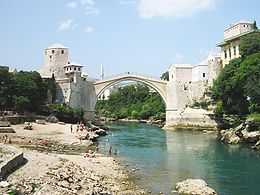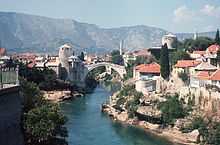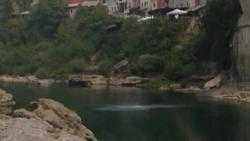Stari Most
| Stari Most | |
|---|---|
 | |
| Official name | Stari most |
| Carries | Pedestrians |
| Crosses | Neretva |
| Locale | Mostar, Bosnia and Herzegovina |
| Design | Arch |
| Total length | 29 metres |
| Width | 4 metres |
| Clearance below | 20 metres at mid-span |
| Opened | 1566/1567/2004 |
| Official name: Old Bridge Area of the Old City of Mostar | |
| Type: | Cultural |
| Criteria: | vi |
| Designated: | 2005 (29th session) |
| Reference No. | 946 |
| State Party: |
|
| Region: | Europe and North America |
Stari Most (English: Old Bridge) is a reconstruction of a 16th-century Ottoman bridge in the city of Mostar in Bosnia and Herzegovina that crosses the river Neretva and connects two parts of the city. The Old Bridge stood for 427 years, until it was destroyed on 9 November 1993 by Croat forces during the Croat–Bosniak War. Subsequently, a project was set in motion to reconstruct it, and the rebuilt bridge opened on 23 July 2004.
One of the country's most recognizable landmarks, it is also considered one of the most exemplary pieces of Islamic architecture in the Balkans and was designed by Mimar Hayruddin, a student and apprentice of the famous architect Mimar Sinan.[1][2][3]
Characteristics

The bridge spans the Neretva river in the old town of Mostar, the city to which it gave the name. The city is the fourth-largest in the country; it is the center of the Herzegovina-Neretva Canton of the Federation of Bosnia and Herzegovina, and the unofficial capital of Herzegovina. The Stari Most is hump-backed, 4 metres (13 ft 1 in) wide and 30 metres (98 ft 5 in) long, and dominates the river from a height of 24 m (78 ft 9 in). Two fortified towers protect it: the Helebija tower on the northeast and the Tara tower on the southwest, called "the bridge keepers" (natively mostari).
The arch of the bridge was made of local stone known as tenelija. The shape of the arch is the result of numerous irregularities produced by the deformation of the intrados (the inner line of the arch). The most accurate description would be that it is a circle of which the centre is depressed in relation to the string course.
Instead of foundations, the bridge has abutments of limestone linked to wing walls along the waterside cliffs. Measuring from the summer water level of 40.05 m (131 ft 5 in), abutments are erected to a height of 6.53 metres (21 ft 5 in), from which the arch springs to its high point. The start of the arch is emphasized by a molding 0.32 metres (1 ft 1 in) in height. The rise of the arch is 12.02 metres (39 ft 5 in).
History


According to the 17th century Turkish traveler Evliya Çelebi, the name Mostar itself means "bridge-keeper." As Mostar's economic and administrative importance grew with the growing presence of Ottoman rule, the precarious wooden suspension bridge over the Neretva gorge required replacement. The old bridge on the river "...was made of wood and hung on chains," wrote the Ottoman geographer Katip Çelebi, and it "...swayed so much that people crossing it did so in mortal fear". In 1566, Mimar Hayruddin, a student of the great architect Sinan, designed Stari Most during the reign of Suleyman the Magnificent. The bridge was said to have cost 300,000 Drams (silver coins) to build. The two-year construction project was supervised by Karagoz Mehmet Bey, Sultan Suleyman's son-in-law and the patron of Mostar's most important mosque complex, called the Hadzi Mehmed Karadzozbeg Mosque.
The bridge, 28 meters long and 20 meters high (90' by 64'), quickly became a wonder in its own time. The famous traveler Evliya Çelebi wrote in the 17th century that: the bridge is like a rainbow arch soaring up to the skies, extending from one cliff to the other. ...I, a poor and miserable slave of Allah, have passed through 16 countries, but I have never seen such a high bridge. It is thrown from rock to rock as high as the sky.[5]
Destruction

Responsibility for the destruction of the bridge is attributed to Bosnian Croat artillery fire.[6][7][8] Starting on 8 November 1993 the Croatian Defence Council (HVO) attacked the bridge with tank fire.[9][10]
Slobodan Praljak, the commander of the Croatian Defence Council, shares direct responsibility with Milivoj Petković (also HVO commander at the time) for destruction of the bridge, according to ICTY judgment in the case against "Prlić and others".[11][12]
During the session on 29 May 2013 the Trial Chamber has sentenced six former Bosnian Croat leaders to a total of 111 years in prison for crimes committed against Bosniaks and other non-Croats in so-called Herceg Bosna. While reading the judgments presiding judge Jean-Claude Antonetti described individual responsibility of the accused for certain crimes, among which destruction of the Stari Most in Mostar (destruction of cultural-historical heritage and property).[13][14][15]
Newspapers based in Sarajevo reported that more than 60 shells hit the bridge before it collapsed.[16] After the destruction of the Stari Most, a spokesman for the Croats admitted that they deliberately destroyed it, claiming that it was of strategic importance.[17] Academics have argued that the bridge held little strategic value and that its shelling was an example of deliberate cultural property destruction. Andras Riedlmayer terms the destruction an act of "killing memory", in which evidence of a shared cultural heritage and peaceful co-existence were deliberately destroyed.[16]
Both sides of the city remained linked until bridge´s reconstruction thanks to the Spanish military engineers assigned to UN UNPROFOR mission.
Reconstruction

After the end of the war, plans were raised to reconstruct the bridge. The World Bank, the United Nations Educational, Scientific and Cultural Organization (UNESCO), the Aga Khan Trust for Culture and the World Monuments Fund formed a coalition to oversee the reconstruction of the Stari Most and the historic city centre of Mostar.[18] Additional funding was provided by Italy, the Netherlands, Turkey, Croatia and the Council of Europe Development Bank, as well as the Bosnian government.[18] In October 1998, UNESCO established an international committee of experts to oversee the design and reconstruction work.[18] It was decided to build a bridge as similar as possible to the original, using the same technology and materials.[18] The bridge was re-built with local materials by Er-Bu Construction Corp a Turkish company, using Ottoman construction techniques.[19] Tenelia stone from local quarries was used and Hungarian army divers recovered stones from the original bridge from the river below.[18] Reconstruction commenced on 7 June 2001. The reconstructed bridge was inaugurated on 23 July 2004.[18]
Diving


Stari Most diving is a traditional annual competition in diving organized every year in mid summer (end of July). It has been done 477 times as of 2013.[20]
It is traditional for the young men of the town to leap from the bridge into the Neretva. As the Neretva is very cold, this is a very risky feat and only the most skilled and best trained divers will attempt it. The practice dates back to the time the bridge was built, but the first recorded instance of someone diving off the bridge is from 1664. In 1968 a formal diving competition was inaugurated and held every summer. The first person to jump from the bridge since it was re-opened was Enej Kelecija, a local who now resides in the United States.[21]
In popular culture
- Smrt Gospodina Goluže - movie by Živko Nikolić
- The album artwork for the album Mojot son e samo moj by SunS depicts a Mostar-like city with the Old Bridge in the background.
See also
- History of Bosnia and Herzegovina
- Tourism in Bosnia and Herzegovina
- Museum of the Old Bridge
- List of World Heritage Sites in Bosnia and Herzegovina
Gallery
-

Stairs on the The Old Bridge in Mostar
-

West side entrance to the The Old Bridge in Mostar
-

East side Tower of the The Old Bridge in Mostar
-

View from The Old Bridge in Mostar
-

Composite image (continuous shot) of a tourist diving from the Stari Most in 2009
-

Street in the Old Town, Mostar
References
- ↑ Balić, Smail (1973). Kultura Bošnjaka: Muslimanska Komponenta. Vienna. pp. 32–34.
- ↑ Čišić, Husein. Razvitak i postanak grada Mostara. Štamparija Mostar. p. 22.
- ↑ Stratton, Arthur (1972). Sinan. New York: Charles Scribner's Sons. ISBN 684-12582-X Check
|isbn=value (help). - ↑ http://www.independent.co.uk/news/croats-destroy-mostars-historic-bridge-1503338.html
- ↑ http://www.saudiaramcoworld.com/issue/199805/hearts.and.stones.htm
- ↑ Traynor, Ian (2004-07-24). "Mostar reclaims Ottoman heritage". The Guardian (London). Retrieved 2010-05-24.
- ↑ Woodard, Colin (2000). "Bosnia: Stillborn". Bulletin of the Atomic Scientists 56 (5): 17–19. doi:10.2968/056004006.
- ↑ Grodach, Carl (2002). "Reconstituting identity and history in post-war Mostar, Bosnia-Herzegovina". City 6 (1): 61–82. doi:10.1080/13604810220142844.
- ↑ Tucker, Spencer (2009) . A Global Chronology of Conflict: From the Ancient World to the Modern Middle East. ABC-CLIO, p. 2630. ISBN 1851096728
- ↑ Wresch, William (1996). Disconnected: Haves and Have-Nots in the Information Age. Rutgers University Press, p 140. ISBN 0813523702
- ↑ "Prlić et al. (IT-04-74)". Case Information Sheet (case homepage) (in Eng.). ICTY. Retrieved 7 October 2013.
- ↑ Del Ponte, Carla (2004-03-02). "The Prosecutor of the Tribunal against Jadranko Prlic, Bruno Stojic, Slobodan Praljak, Milivoj Petkovic, V alentin Coric and Berislav Pusic: Indictment". ICTY. Retrieved 2010-01-17.
- ↑ Goran Jungvirth (29 May 2013). "Presuda čelnicima "Herceg Bosne": 111 godina za stvaranje Velike Hrvatske". Radio Free Europe (Radio Slobodna Evropa) (in Bosnian). slobodnaevropa.org. Retrieved 7 October 2013.
- ↑ SENSE (29 May 2013). "111 YEARS IN PRISON FOR HERCEG BOSNA LEADERS". SENSE Agency - SENSE Tribunal (in Eng.). sense-agency.com. Retrieved 7 October 2013.
- ↑ "Judgment - Open session reading" (txt / html). ICTY (in Eng.). icty.org. 29 May 2013. Retrieved 7 October 2013.
- ↑ 16.0 16.1 Coward, Martin (2009). Urbicide: The Politics of Urban Destruction. London: Routledge. pp. 1–7. ISBN 0-415-46131-6.
- ↑ Borowitz, Albert (2005). Terrorism for self-glorification: the herostratos syndrome. Kent State University Press. p. 65. ISBN 0-87338-818-6.
- ↑ 18.0 18.1 18.2 18.3 18.4 18.5 Armaly, Maha; Blasi, Carlo; Hannah, Lawrence (2004). "Stari Most: rebuilding more than a historic bridge in Mostar". Museum International 56 (4): 6–17. doi:10.1111/j.1468-0033.2004.00044.x.
- ↑ http://www.gen-eng.florence.it/starimost/00_main/main.htm
- ↑ "Mostar". Gradmostar.blogger.ba. Retrieved 2013-10-05.
- ↑ http://www.pluska.sk/showdoc.do?docid=12602&showRate=true
External links
| Wikimedia Commons has media related to Stari Most. |
- Rehabilitation Design of the Old Bridge of Mostar
- Bosnia and Herzegovina Commission for Preservation of National Monuments - The Stari Most
- Before, during and after destruction, pictures taken by Belgian photographer Laurent Van der Stockt - Time magazine
- Live webcams from Stari most and the Old town. (mirror)
Coordinates: 43°20′13.56″N 17°48′53.46″E / 43.3371000°N 17.8148500°E